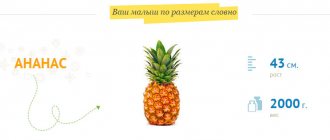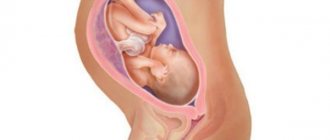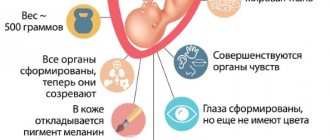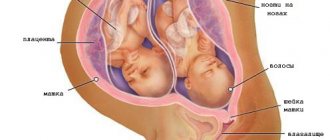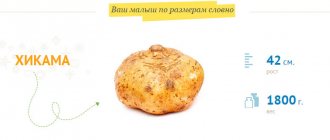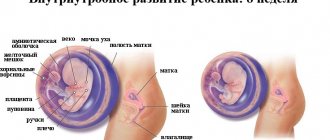Fetus
The fetus at the 32nd obstetric week of pregnancy already knows the mother’s voice well, feels the beating of her heart and the sound of breathing, and her eyes are able to react to light. The immune system is formed, from immunoglobulins obtained from the mother’s body, a supply of antibodies necessary for protection in the first months after birth is formed.
The brain is almost formed, the size of the head in relation to the body becomes more proportional. The layer of subcutaneous fat cells increases, the arms and legs acquire a pleasant roundness, the face becomes smooth, and the baby’s weight rapidly increases at 32 weeks of pregnancy.
The lanugo fluff is slowly being replaced by the first hairs, and the nervous system and sucking muscles continue to actively develop. At week 32, the baby’s main development is complete, and the baby is now growing rapidly, preparing for birth.
Due to the significant weight of the upper body, in most cases the child falls head down by this period. He can change his position more than once, but over time it becomes more and more difficult; there is not enough free space for the “maneuver”.
If breech presentation persists at 32 weeks of pregnancy, then in the future this may become an indicator for a planned cesarean section.
Specifics of pregnancy in a woman carrying twins
Multiple pregnancy often becomes a test for the female body. After all, compared to regular ones, it places more stringent demands on health.
All patients expecting twins should attend antenatal clinics more often than is necessary for a singleton pregnancy.
The duration of pregnancy is inversely proportional to the number of fetuses. For example, with twins it will be approximately 37 weeks, with triplets - already 35 weeks (the gestation period for one child is the standard 40 weeks). This is due to the fact that an overstretched uterus becomes increasingly difficult to hold babies.
When expecting twins, a woman begins to feel all the possible “delights” of pregnancy, including complications, earlier, and they are more pronounced:
- Toxicosis. It appears earlier than during normal pregnancy. It is more severe and continues until the 17th week (when carrying one child, it ends by the 13th week).
- As the fetuses grow, the enlarged uterus provokes a displacement of the diaphragm. The heart of the expectant mother suffers from this: she early begins to feel a rapid heartbeat, weakness, shortness of breath, and fatigue.
- The growing uterus puts pressure on the stomach and intestines. The result is constipation, belching, and heartburn in the early stages.
- Compression of the inferior vena cava leads to early varicose veins.
- Compression of the bladder provokes more frequent urination (even in the second trimester, when a woman carrying one fetus experiences some relief in this regard).
- The volume of circulating blood in a woman’s body increases. If when carrying one child this figure is 40–50%, then with multiple births it is already 50–60%. As a result, there is a lack of vitamins and macroelements, especially iron. Therefore, early anemia almost always accompanies women expecting twins: they have to take medications throughout the pregnancy.
- When carrying two fetuses, the risk of developing polyhydramnios is higher, and this negatively affects the kidneys of the expectant mother.
- Preeclampsia. If during a normal pregnancy 30% of expectant mothers encounter it, then during a multiple pregnancy it is already 50%.
- All those expecting twins experience swelling and arterial hypertension in the second half of pregnancy. This is how the body responds to the growing needs of the fruit.
- Gestational diabetes develops more often.
- If there was a certain chronic disease before pregnancy, then it will definitely get worse, because the body is under a lot of stress.
- If the twins are fraternal, then the likelihood of incompatibility between the blood of the mother and the fetus increases. After all, they may well have a different group and Rh factor.
- With multiple pregnancy, isthmic-cervical insufficiency very often occurs - a pathology in which the cervix opens slightly before childbirth (especially if the woman has already given birth). This is due to a mechanical factor: the large volume and weight of the uterus, its overstretching. This condition develops after 22 weeks and progresses rapidly. The expectant mother is given stitches on the cervix, and if she is expecting triplets, a special pessary is also used (since the stitches can cut through from the load).
- When two or more placentas are attached to the uterus, one of them may be located low or presentation may occur.
Photo gallery: specifics of multiple pregnancy
In multiple pregnancies, edema cannot be avoided
Women carrying twins suffer from anemia from early pregnancy
With multiple pregnancy, varicose veins are more likely and occur earlier due to early compression of the inferior vena cava
With multiple pregnancies, toxicosis begins earlier, ends later and is more severe.
One of the placentas may be too low in the uterus
An expectant mother expecting twins (and even more so triplets) urgently needs enhanced nutrition. If an ordinary pregnant woman should receive approximately 2500 kcal per day, then one expecting twins should receive at least 4500 kcal. In addition, you need to not just saturate the body (lean on flour products), but eat food rich in nutrients. During pregnancy, such a woman usually gains 16–21 kg, but if the fetus is alone, this figure is 9–14 kg.
To prevent premature birth, the gynecologist usually recommends limiting physical activity: in addition to sleeping at night, the expectant mother needs to lie down more during the day. If there is a threat of premature birth, bed rest is required.
Multiple pregnancies after a cesarean section require special attention. There are two main dangers here:
- Scar rupture due to too much stress on the uterus.
- Premature placental abruption or placental previa.
Multiple pregnancy after a cesarean section requires artificial delivery.
Feel
An enlarged uterus puts constant pressure on the surrounding internal organs, which does not go without consequences. After eating, nausea, belching and heartburn may occur, breathing becomes difficult, and intestinal motility is disrupted.
In the last trimester, a delicate problem often arises - hemorrhoids. After visiting the toilet, it is optimal to rinse with warm water; if pain or discomfort occurs, you should consult your doctor.
The 32nd obstetric week of pregnancy inevitably passes with painful or pulling sensations in the pelvis and lower back, which is associated with weight gain and a shift in the center of gravity. The breasts become more sensitive, increase in size, a venous network is visible on its surface, the nipples and their areolas darken. Changes are also possible in the intimate area.
Discharge
Normally, moderate, homogeneous milky discharge with or without a slight sour odor. At the 32nd obstetric week of pregnancy, discharge with bloody streaks, purulent, and an unpleasant odor should alert you. Such changes indicate the development of an infection, which can lead to unpleasant and even tragic consequences.
Watery discharge at 32 weeks of pregnancy is also an alarming sign, which indicates premature rupture of amniotic fluid. To exclude this possibility, purchase a special test at the pharmacy.
Pain
There are 2 months left before the birth, so the pregnant woman’s body is gradually preparing for this event. Pain at 32 weeks of pregnancy worries a woman in the back, lower back and legs. This is associated with an increase in weight, belly and uterus. The center of gravity shifts, increasing the load on the back and lower limbs. Swelling of the legs and arms at this stage is normal.
Often a pregnant woman feels a sharp pain in the chest area. It's the baby pushing. Since the uterus is still in an elevated position, all blows fall under the ribs.
Also at week 32, training uterine contractions continue. They manifest themselves as slight pain in the lower abdomen.
Well-being
As pregnancy approaches its logical conclusion, it becomes more and more difficult. The load is felt throughout the body. One thought arises: when will the long-awaited birth come? The mother's body has to work for two.
He may not be able to suckle on his own at first, but in any case, he will need your milk. It will come, despite the fact that the birth occurred prematurely, and there is no better food for the child. If the child has no other problems other than being born prematurely, he will grow up healthy.
If you are pregnant with twins and have carried your babies to 33 weeks, that’s great! At least two more weeks, and after birth they will most likely be able to go straight home with you from the hospital, being mature enough. Now we can sympathize with you, it’s very difficult for you, your stomach has reached its maximum size, it’s difficult to walk, and putting on shoes on your own is a complete problem. Be patient, there's not much left.
Our partner
A cold will not cause any complications during pregnancy. But it's better to take care of yourself.
You won't be envied now. My back hurts, my legs ache, my stomach is so huge that you can use it instead of a table while sitting in front of the TV. Okay, jokes aside! In fact, these inconveniences are experienced for a good cause. Pregnant women with triplets could already give birth. 33-34 obstetric weeks are just right for this! If you're pregnant with twins, you just have to wait a little longer. Not everything in your pregnancy was rosy, but there was one final push left. If you could hold out for another 2-3 weeks that would be great!
34 weeks pregnant with twins
Childbirth at 32 weeks of pregnancy
If the baby decides to be born prematurely, then this can happen completely suddenly. Therefore, the mother should be wary of any non-standard conditions, for example:
- sudden onset of diarrhea;
- periodic abdominal pain;
- increased frequency of training contractions up to 5 attacks per hour;
- copious watery or bloody discharge of any volume.
Childbirth at 32 weeks almost always ends successfully. However, the baby is not yet ready for independent life, so the mother needs to try to ensure that they occur under the supervision of specialists.
Recommendations
A pregnant woman during this period must adhere to certain rules.
Nutrition
A woman should receive adequate nutrition at 32 weeks of pregnancy, but should not overeat. Normally, no more than 4 meals a day, trying not to increase the serving size. The best suppliers of protein: lean boiled beef, rabbit, turkey. Chicken meat should be consumed in moderation, as it is one of the most allergenic foods.
Steamed and baked fish, sea fish are especially rich in vitamins and iodine. It is better to minimize salt consumption, and be sure to follow a drinking regime.
Vitamins
For proper metabolism, you need a sufficient amount of microelements and vitamins obtained from food. If a pregnant woman, according to tests and external signs, has vitamin deficiency or anemia, a specialist prescribes taking multivitamins. You shouldn’t refuse them, just like you shouldn’t prescribe medications yourself.
Sex at 32 weeks pregnant
If there is no prohibition, then sex at 32 weeks is quite acceptable and even useful, since male sperm contains prostaglandins, which are necessary to facilitate the dilatation of the cervix during childbirth.
It is impossible to harm the child, nature has taken good care of this, but you will have to avoid positions that cause pressure on the stomach.
Increased sexual desire, as well as reluctance to have sexual intercourse, are normal variants and should not cause concern in a pregnant woman.
Physical activity
Simple exercises help maintain muscle tone, improve blood supply to all systems and internal organs, and saturate with oxygen. Strong muscles and proper breathing will help during childbirth and the recovery period. Weak muscles cause various problems, including back pain.
Pregnancy is not a disease; you don't need to lie in bed all day. Walking in the fresh air, aerobics, swimming, and light gymnastics not only improve physical well-being, but also have a positive effect on your mood.
Medicines and medical procedures
You must strictly follow the doctor's recommendations. You should not choose your own medications, even during a cold or headache at the 32nd obstetric week of pregnancy.
Types of oligohydramnios
The symptoms of this disease are not particularly pronounced. And women more often do not notice that any deviations of this nature have appeared. Basically, only a specialist using ultrasound to identify it is the only correct option. But sometimes it can be supplemented with Doppler ultrasound, the results of which will show the true picture of the quality of blood flow and the baby’s possible developmental delay. Also, at the same time, smears for microflora and fetal CTG are taken.
As for how this pathology can be dealt with, it’s all about an effective scheme that is developed directly by the gynecologist. The main aspect is the severity of the disease.
If, based on the results of the studies, it turns out that the main cause of oligohydramnios is obesity or metabolic disorders, the gynecologist usually prescribes medications to the patient that normalize the placental state. In other cases, complex treatment and vitamins are prescribed without fail. It is also worth noting that a woman should avoid any physical activity.
There are situations when increased uterine tone is detected. Then the pregnant woman is immediately sent to hospital treatment in order to control the disease and prevent deterioration.
Possible problems
If movements at 32 weeks of pregnancy are not felt throughout the day, prolonged pain occurs in the abdomen, or diarrhea or bleeding suddenly begins, then you must urgently contact a doctor or call an ambulance. This may be a signal of problems with the baby or the onset of premature labor.
If you experience symptoms of colds, runny nose, cough, or malaise, you should contact your gynecologist. Having assessed the woman’s condition, the doctor will prescribe medications that will bring maximum benefit and will not affect the development of the baby.
Polyhydramnios and oligohydramnios at 32 weeks of pregnancy
Both of these pathologies of amniotic fluid are dangerous because they cause fetal malformations and problems during childbirth. Therefore, it is important to identify them as early as possible. Signs of polyhydramnios and oligohydramnios at 32 weeks of pregnancy may include:
- nagging pain in the lower abdomen;
- weakness;
- nausea, vomiting;
- water leakage
If you notice at least one of these signs, be sure to consult a specialist. If pathology is suspected, he will most likely prescribe an ultrasound and other studies at 32 weeks of pregnancy.
Movements: how to do a test
As practice shows, the norm for movements in a given period of time is about fifteen times every hour. This is explained by the fact that the baby has already developed his own rhythm of sleep and wakefulness. The child’s behavior at this moment is easy to track, creating a picture of his maximum mobility and least activity.
But there are times when a woman does not feel this kind of manifestation from her own child for a long time. This creates anxiety and a feeling that something has happened to him. Of course, you can go to a gynecologist so that he can listen to the baby’s heartbeat and, if necessary, prescribe additional checks. But first of all, you can do a small and fairly simple Pearson test, which will allow you to first make sure that everything is okay with the baby.
Movements: how to do a test
To do this, you need to prepare a regular paper sheet of a convenient format and draw a special sign there. It is in it that in the corresponding column you need to mark every tenth movement from 9 o’clock in the morning until 9 o’clock in the evening. When the latest results have already been entered, conclusions can be drawn. So, if in the end the total number of movements is ten or more, then there is no reason to worry, everything is normal. But if this figure is lower, this is a reason not to delay going to the doctor for advice.
Ultrasound
A biochemical blood test is required and third trimester screening is prescribed with a planned ultrasound at 32 weeks of pregnancy. Screening is usually carried out at 32–34 weeks, but there are individual differences.
The study helps to get an idea of the degree of maturity of the placenta, the size and position of the fetus, and the possibility of entanglement with the umbilical cord. The condition of the amniotic fluid, its quantity and the presence of impurities is assessed. If serious pathologies such as low or polyhydramnios are detected at 32 weeks of pregnancy, the doctor must immediately take measures to eliminate them.
Interpretation of ultrasound readings at 32 weeks of pregnancy contains other important information that covers the condition of the baby’s internal organs and systems, their degree of maturity and possible pathologies. The gynecologist leading the pregnancy will review the report and determine how well the indicators correspond to ultrasound standards at 32 weeks.
Signs and diagnosis of multiple pregnancy
In the early stages, only ultrasound can accurately determine multiple pregnancy. So, already at a period of five weeks you can see two (or more) embryos in the uterus, and also differentiate multiple pregnancy from hydatidiform mole or fibroids.
Before the advent of ultrasound, diagnosing multiple pregnancy was quite difficult. This could only be reliably done in the later stages, and sometimes only during childbirth.
In addition, the presence of twins can be suspected if the level of the hCG hormone in the blood is too high, which does not correspond to the gestational age. At the same time, progesterone will also increase.
Table: hCG norms during pregnancy with twins and one fetus
| Gestational age in weeks | Multiple pregnancy | Singleton pregnancy |
| 1–2 | 50–340 | 25–156 |
| 2–3 | 208–9740 | 101–4870 |
| 3–4 | 2220–63000 | 1110–31500 |
| 4–5 | 5120–164600 | 2560–82300 |
| 5–6 | 46200–302000 | 23100–151000 |
| 6–7 | 54600–466000 | 27300–233000 |
| 7–11 | 41800–582000 | 20900–291000 |
| 11–16 | 12280–206000 | 6140–103000 |
| 16–21 | 9440–160200 | 4720–80100 |
| 21–39 | 5400–15600 | 2700–78100 |
An expectant mother may suspect that she is pregnant with twins even based on the results of a routine pregnancy test. The treasured second stripe will become bright too early, sometimes even before the delay. This is again due to a high level of hCG, but in the urine.
In case of multiple pregnancy, the second stripe may become bright very early
When the doctor examines the expectant mother in a gynecological chair, due to the presence of two embryos, the uterus will be too large: the size does not correspond to the period of the missed period.
Another sign of multiple pregnancy in the early stages is too pronounced toxicosis (severe nausea, vomiting, aversion to smells) and very swollen mammary glands (although, of course, some people experience this condition even during a standard pregnancy with one fetus).
As for the second trimester of gestation, the following signs are characteristic of multiple pregnancy:
- There is a sharp growth of the uterus. The abdominal circumference will significantly exceed the norm typical for bearing one child. In addition, the height of the bottom of the organ will be greater.
- By palpation, the doctor can identify large parts of the fruit (these are two heads, two pelvises), as well as many small parts.
- The heartbeat will be heard in two different areas of the abdomen, and there will be a silent zone between them. Moreover, the heart rate of fetuses often varies (up to ten beats per minute).
- A woman may feel movement too early. The reason for this is that the amount of free space in the uterus is rapidly decreasing, and even minor movements of the fetus can be recorded. So, if during the first singleton pregnancy movement begins at about 20 weeks, during the second - from 18 weeks, then when expecting twins, movements can be felt already from 15 weeks.
During a multiple pregnancy, a woman usually feels the first movements much earlier.
Ultrasound examinations when carrying twins are also carried out in the second and third trimester. It makes it possible to assess the nature of fetal development: the number of placentas, the uniformity of development of babies, and to record conjoined twins.
